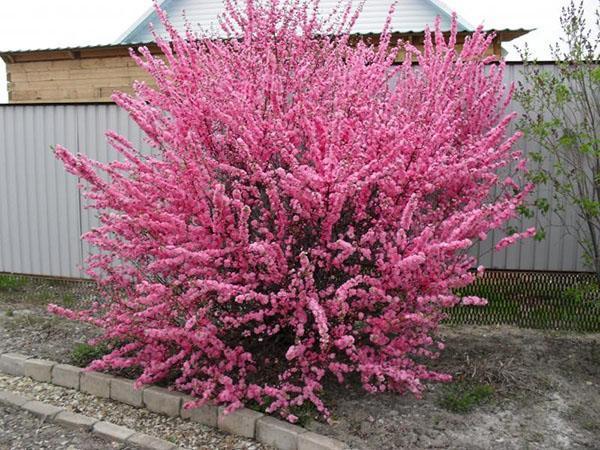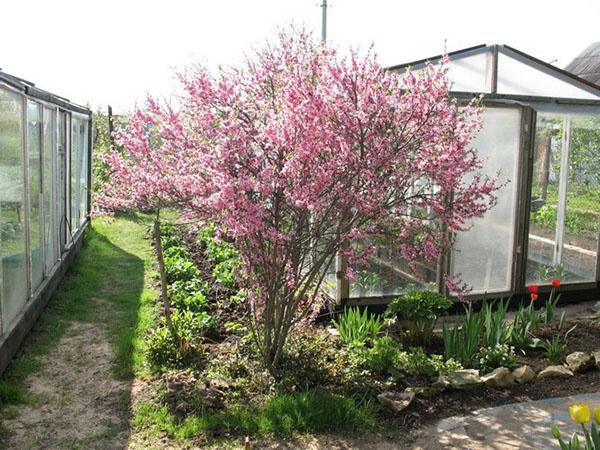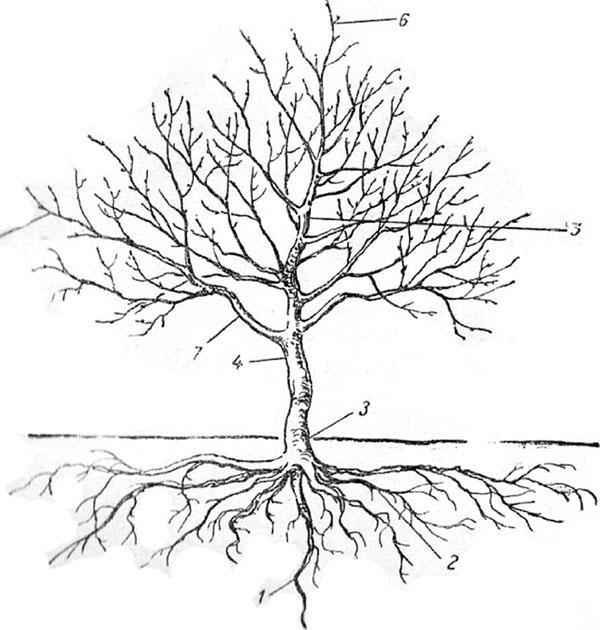Planting and caring for almonds: the importance of planning
 In the conditions of the middle zone of Russia and Ukraine, it is almost impossible to grow a real "Amygdalus Communis fruiting" (Latin name), since the seedlings cannot stand the harsh winters of this territory. Still, planting and caring for Luiseania and Bobovnik almonds brings amazing results. To distinguish between the two varieties, you need to pay attention to the structure of their leaves. In the first case, they are corrugated, embossed, and in the second - smooth, glossy.
In the conditions of the middle zone of Russia and Ukraine, it is almost impossible to grow a real "Amygdalus Communis fruiting" (Latin name), since the seedlings cannot stand the harsh winters of this territory. Still, planting and caring for Luiseania and Bobovnik almonds brings amazing results. To distinguish between the two varieties, you need to pay attention to the structure of their leaves. In the first case, they are corrugated, embossed, and in the second - smooth, glossy.
Winter-hardy crops of the genus Plum (Pink family) do not need special care, while they are perfectly grafted on other plants (plum or cherry). Moreover, in the southern regions, shrubs do not have to be covered for the winter.
During the flowering period, the thermophilic plant forms a luxurious "pink cloud", which will become an excellent decorative element of the garden. While some buds set fruit, they are not edible. Due to the pronounced bitter taste, nuts are not used for food. However, there are varieties with sweet nuts. How to grow such a charm on your site?
Easy planting and routine care of almonds

Greek merchants brought the drought-resistant culture to Russia from Asia. This area is dominated by a dry and sultry climate. A powerful root system helps the plant survive in such conditions.  It consists of 5 thick skeletal branches that penetrate several meters into the ground. Understanding this feature, the gardener will be able to properly care for the ornamental tree.
It consists of 5 thick skeletal branches that penetrate several meters into the ground. Understanding this feature, the gardener will be able to properly care for the ornamental tree.
Almonds should be planted in late autumn. The overwintered rhizome quickly adapts to new weather conditions. As a result, the young bush takes root several times faster.
Seedling planting algorithm
 The most important thing in this business is choosing the right place. Exotic cultures love sunny and cozy (draft-free) areas of the garden. It is desirable that this is the southern side of the estate. Some have shrubs behind the house, others in the courtyard of the dacha, and still others near the fence. Almonds are planted according to the following convenient scheme:
The most important thing in this business is choosing the right place. Exotic cultures love sunny and cozy (draft-free) areas of the garden. It is desirable that this is the southern side of the estate. Some have shrubs behind the house, others in the courtyard of the dacha, and still others near the fence. Almonds are planted according to the following convenient scheme:
- dig a hole of standard sizes (depth up to 1 m, with each side of the square being 100 cm);
- cover 1/3 of the funnel with humus (approximately a bucket), especially if the soil consists of clay or sand;
- make 60-100 g of complex mineral fertilizers (mostly phosphoric);
- all components are mixed with earth, filling ½ part of the pit;
- spilled with water;

- gently straighten the roots of almond seedlings on the formed mound;
- fall asleep with the remaining planting substrate;
- pressed tightly near the basal neck, which is not too deep;
- moisten the soil again;
- landing circle mulch using peat.
Experienced gardeners should know how deep the groundwater is in their area. This indicator plays an important role in planting and caring for almonds, because it does not tolerate high humidity.
Each individual plant is watered with 7-10 liters of warm water. It is often recommended to use settled or rainwater. It will only be beneficial when good drainage is made at the bottom of the pit. To form it, use:
To form it, use:
- fragments of bricks;
- crushed stone;
- sand;
- fine gravel;
- ordinary stones.
In this case, the proposed components can be safely mixed with each other. Thanks to such a textured layer, the water will not stagnate, much less swamp the soil.
The structure of the earth must be loose, porous, and therefore air and water permeable. It is contraindicated to choose acidic, saline, clayey and chlorine-containing soil for the shrub. In this case, dolomite flour or lime (300 g per 1 m²) must be added.
Painstaking seed cultivation
 Many fans of exotic cultures are interested in the question of how to plant almonds from the stone. Basically, the plant reproduces by shoots, you can still try to germinate a nut. For such an event, healthy, undamaged planting material is selected. Further, the procedure is carried out in this way:
Many fans of exotic cultures are interested in the question of how to plant almonds from the stone. Basically, the plant reproduces by shoots, you can still try to germinate a nut. For such an event, healthy, undamaged planting material is selected. Further, the procedure is carried out in this way:
- 10-20 seeds are soaked in a strengthening solution for a day;

- the earth with humus is carefully dug up so that it is as loose as possible;
- form holes 10-15 cm deep;
- the distance between the pits is 20 cm;
- 2 bones are placed in each funnel;
- compact the area tightly.
When the seedlings grow to 15 cm, their root system is pruned. To do this, they take a sharp shovel and cut the shoots together with the ground at a depth of 10-15 cm. Then they are abundantly irrigated with warm water. A year later, an annual copy is transplanted. This procedure contributes to the formation of a beautiful, lush crown.
Using this reproduction method, it should be borne in mind that the culture loses all its biological and external characteristics. Hybrid varieties are often susceptible to the harmful effects of pests and dangerous diseases.
It should be noted that for group plantings, the row spacing should not be less than 6 m. 3-4 m are left between individual specimens.The depth of the planting hole is 70 cm. In addition, fertile soil will consist of:
- rotted manure - 5 kg;
- superphosphate - 500 g;
- 3 parts deciduous substrate;
- 2 hours of cow dung;
- 1 part river sand.
Taking into account the listed features, almonds are planted in the open ground and taken care of. However, the lion's share of success in this matter is a well-designed plan for caring for a shrub or tree.
Perfect care of the almond tree
 In the first years of life, the seedling needs abundant, and most importantly, regular watering. Therefore, every 14 days, the trunk circle is moistened with 5-7 liters of warm liquid. For adult exhibits, the event is held once a month and up to 10 liters of water is poured in.
In the first years of life, the seedling needs abundant, and most importantly, regular watering. Therefore, every 14 days, the trunk circle is moistened with 5-7 liters of warm liquid. For adult exhibits, the event is held once a month and up to 10 liters of water is poured in.
For the first 5-7 years, the farmer carefully monitors that the seedling does not get sick. To increase its immunity, the aisles are sown with green manure.
A feature of how to grow almonds in the country is the periodic loosening of the soil. At the end of March, when the threat of night frosts passes, they raise the mulch and weed the ground (planting depth - 10 cm). The operation is repeated 4 more times throughout the growing season, but not too deeply - up to 6-7 cm. This has a beneficial effect on the growth of the shrub, as well as a number of the following procedures:
- Pruning almonds in fall and spring. After the plant has shed all the leaves (or before the buds appear), the dried, frozen, diseased, abnormally growing and deformed branches are cut off. During this period, it is important to thin out the crown. But the shaping pruning is started immediately after flowering.

- Top dressing is carried out regardless of the state of the culture. In early spring, as soon as the snow melts, mineral fertilizers are applied (at the rate of 50-70 g / 1 m²). Then turn on the sprinkler so that the earth absorbs the fertilizing.You can also use this mixture: superphosphate (40 g), as well as potassium sulfide (20 g), are added to 1 kg of manure.

- Transplanting almonds in the fall. After formation / sanitary pruning, many growths are formed around the crop. The seedlings are detached from the mother plant for 2 years. By that time, their root system will be sufficiently developed.

After removing the thick branch, the cut is treated with garden pitch. This protective coating will protect the plant from infections, viruses and bacteria.
The tree does not tolerate gusty winds and drafts. Therefore, for young seedlings, it is advised to make 1.5-meter supports. In some cases, protective screens made of building materials are erected near the bush.
Features of cultivation in certain regions of Russia
 In very harsh climatic conditions, it is recommended to cover the tree for the winter, even despite its unpretentious "character". Sometimes spunbond or burlap is used, but snow is still the best natural insulator.
In very harsh climatic conditions, it is recommended to cover the tree for the winter, even despite its unpretentious "character". Sometimes spunbond or burlap is used, but snow is still the best natural insulator.
 At the same time, it is worth knowing what varieties to plant in your country house. Here is what experts advise for the following regions of Russia:
At the same time, it is worth knowing what varieties to plant in your country house. Here is what experts advise for the following regions of Russia:
- Planting and caring for almonds in Siberia. For these purposes, only a few varieties are suitable. Gardeners noted that it is very easy to care for the bean, a low and steppe variety. Young shoots freeze slightly at -15˚С, so they are pinched at the end of August.

- Growing almonds in the Krasnodar Territory. This is the most suitable location for its successful growth. The temperate warm climate allows commercial companies to grow entire plantations of Asian plants. In these places, you can try to plant a fruitful variety. However, there is no guarantee that the gardener will receive the long-awaited fruits.
- Almonds in the suburbs. Planting and caring for a tree in such a region requires special effort. The first step is to keep in mind that winters in these parts are very harsh, so the bushes need shelter. Among other things, high humidity and acidic clayey soil negatively affect the plant.
 For the central strip, choose Luiseania three-bladed. It is also called sakura from the Moscow region. The variety is most adapted to cool climatic conditions. So the conclusion is obvious. Planting and caring for almonds is easy enough. Nevertheless, the shrub will delight the owners only with its decorative properties, bitter or sweet kernels, and not with delicious aromatic fruits.
For the central strip, choose Luiseania three-bladed. It is also called sakura from the Moscow region. The variety is most adapted to cool climatic conditions. So the conclusion is obvious. Planting and caring for almonds is easy enough. Nevertheless, the shrub will delight the owners only with its decorative properties, bitter or sweet kernels, and not with delicious aromatic fruits.